Choosing an Electrical Switch
More
Safety Limit Switches
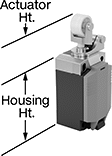
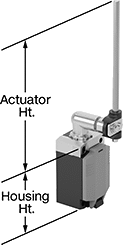
Protect machinery and ensure the safety of personnel—these switches have positive-force contacts that will open the circuit when actuated even if a spring fails or the contacts stick. When an object in motion comes into contact with the actuator, it sends a signal to open or close a circuit. These switches have the rapid-closing action of a snap-acting switch, but with a larger actuator. This makes them a good choice for use with large objects—for instance, a box on a conveyor runs into the switch, stopping the conveyor.
Switches with a roller lever actuator use a lever with a roller at the end to activate. This allows parts to glide across the actuation surface with minimal friction, limiting wear and tear on your switch.
Switches with a rod actuator use a rod extending out of the body to actuate, so they’ll activate even if an object is far away.
Styles D, E, and F have an actuator that allows you to adjust its height, making it easier to align switch with the target during installation.
Switches with a steel actuator are more durable than switches with a plastic actuator. They also handle higher loads.
Switches with a plastic actuator limit wear and tear on passing objects better than switches with a steel actuator.
Housing | |||||||||||||||||
|---|---|---|---|---|---|---|---|---|---|---|---|---|---|---|---|---|---|
| Style | No. of Circuits Controlled | Switch Starting Position | Switch Action | Industry Designation | Actuator Material | Switching Current @ Voltage | Max. Voltage | Operating Temp. Range, °F | Actuator Ht. | Wire Connection Type | Lg. | Ht. | Dp. | Housing Material | Environmental Rating | Each | |
Roller Lever Actuator Style | |||||||||||||||||
| C | 1 | 1 Off (Normally Open) or 1 On (Normally Closed) | Springs Back (Momentary) | SPDT | Plastic | 3 A @ 240 V AC, 1.5 A @ 24 V DC | 240V AC 24V DC | -22° to 165° | 1.5" | Screw Terminals | 1.7" | 2.9" | 1.6" | Plastic | NEMA 4X, IP66, IP67 | 00000000 | 0000000 |
Rod Actuator Style | |||||||||||||||||
| F | 1 | 1 Off (Normally Open) or 1 On (Normally Closed) | Springs Back (Momentary) | SPDT | Steel | 3 A @ 240 V AC, 1.5 A @ 24 V DC | 240V AC 24V DC | -22° to 165° | 0.5"-8" | Screw Terminals | 1.7" | 2.9" | 1.6" | Plastic | NEMA 4X, IP66, IP67 | 00000000 | 000000 |
Compact Safety Limit Switches
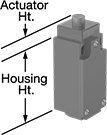
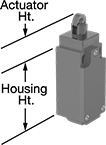
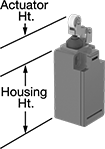
Shorter and thinner than other safety limit switches, these are sized to fit tight spaces. They protect machinery and ensure the safety of personnel. Positive-force contacts open the circuit when actuated, even if a spring fails or the contacts stick. They send a signal to your circuit when an object hits the actuator—for instance, a box on a conveyor runs into the switch, stopping the conveyor. They open and close circuits as fast as snap-acting switches, but they have a bigger actuator for large objects. All are NEMA and IP rated for protection from washdowns.
Switches with a plunger actuator require a push to activate, similar to a button.
Switches with a roller plunger actuator have a roller that moves parallel to the mounting direction when an object pushes the actuator. This reduces friction during actuation to limit wear and tear.
Switches with a roller lever actuator use a lever with a roller at the end to activate. This allows parts to glide across the actuation surface with minimal friction, limiting wear and tear.
Housing | ||||||||||||||||
|---|---|---|---|---|---|---|---|---|---|---|---|---|---|---|---|---|
| Style | No. of Circuits Controlled | Switch Starting Position | Switch Action | Industry Designation | Switching Current @ Voltage | Max. Voltage | Operating Temp. Range, °F | Actuator Ht. | Wire Connection Type | Lg. | Ht. | Dp. | Housing Material | Environmental Rating | Each | |
Plunger Actuator Style | ||||||||||||||||
| A | 1 | 1 Off (Normally Open) or 1 On (Normally Closed) | Springs Back (Momentary) | SPDT | 10 A @ 240 V AC, 4 A @ 24 V DC | 240V AC 24V DC | -22° to 176° | 0.5" | Screw Terminals | 1.2" | 2.4" | 1.2" | Plastic | NEMA 4, IP65 | 00000000 | 0000000 |
Roller Plunger Actuator Style | ||||||||||||||||
| B | 1 | 1 Off (Normally Open) or 1 On (Normally Closed) | Springs Back (Momentary) | SPDT | 10 A @ 240 V AC, 4 A @ 24 V DC | 240V AC 24V DC | -22° to 176° | 1.2" | Screw Terminals | 1.2" | 2.4" | 1.2" | Plastic | NEMA 4, IP65 | 00000000 | 000000 |
Roller Lever Actuator Style | ||||||||||||||||
| C | 1 | 1 Off (Normally Open) or 1 On (Normally Closed) | Springs Back (Momentary) | SPDT | 10 A @ 240 V AC, 4 A @ 24 V DC | 240V AC 24V DC | -22° to 176° | 1.1" | Screw Terminals | 1.2" | 2.4" | 1.2" | Plastic | NEMA 4, IP65 | 00000000 | 000000 |
Subminiature Snap-Acting Switches
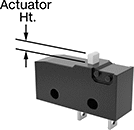
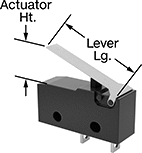
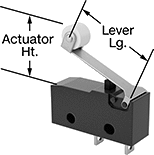
At least 25% smaller than our Miniature Snap-Acting Switches, these switches are often used to trigger actions from inside a vehicle’s door or an engine compartment. They open and close circuits faster than other switches, preventing contacts from sticking by reducing the time that they're near one another. They also minimize the chance of arcing, so electricity won’t jump across contacts.
Plunger actuator switches send a signal when the actuator is pushed directly downward. They have the smallest actuator of the actuators here, reducing the risk of accidental switching.
Lever actuator switches have a larger surface area than plunger actuator switches and can be pushed down by front-to-back movement, so they require less precision to activate.
Roller lever actuator switches allow parts to glide across the actuation surface with less friction than standard levers. This prevents wear and tear over time.
Housing | ||||||||||||||
|---|---|---|---|---|---|---|---|---|---|---|---|---|---|---|
| No. of Circuits Controlled | Switch Starting Position | Switch Action | Industry Designation | Switching Current @ Voltage | Max. Voltage | Operating Temp. Range, °F | Actuator Ht. | No. of Terminals | Lg. | Ht. | Dp. | Lever Lg. | Each | |
Plunger Actuator Style | ||||||||||||||
With Tab Terminals | ||||||||||||||
| 1 | 1 Off (Normally Open) | Springs Back (Momentary) | SPST-NO | 10 A @ 250 V AC | 250V AC | -40° to 185° | 0.09" | 2 | 0.79" | 0.36" | 0.26" | __ | 0000000 | 00000 |
| 1 | 1 On (Normally Closed) | Springs Back (Momentary) | SPST-NC | 10 A @ 250 V AC | 250V AC | -40° to 185° | 0.09" | 2 | 0.79" | 0.36" | 0.26" | __ | 0000000 | 0000 |
| 1 | 1 Off (Normally Open) or 1 On (Normally Closed) | Springs Back (Momentary) | SPDT | 10 A @ 250 V AC | 250V AC | -40° to 185° | 0.09" | 3 | 0.79" | 0.36" | 0.26" | __ | 0000000 | 0000 |
Lever Actuator Style | ||||||||||||||
With Tab Terminals | ||||||||||||||
| 1 | 1 Off (Normally Open) | Springs Back (Momentary) | SPST-NO | 10 A @ 250 V AC | 250V AC | -40° to 185° | 0.29" | 2 | 0.79" | 0.36" | 0.26" | 0.75" | 0000000 | 0000 |
| 1 | 1 On (Normally Closed) | Springs Back (Momentary) | SPST-NC | 10 A @ 250 V AC | 250V AC | -40° to 185° | 0.29" | 2 | 0.79" | 0.36" | 0.26" | 0.75" | 0000000 | 0000 |
| 1 | 1 Off (Normally Open) or 1 On (Normally Closed) | Springs Back (Momentary) | SPDT | 10 A @ 250 V AC | 250V AC | -40° to 185° | 0.29" | 3 | 0.79" | 0.36" | 0.26" | 0.75" | 0000000 | 0000 |
Roller Lever Actuator Style | ||||||||||||||
With Tab Terminals | ||||||||||||||
| 1 | 1 Off (Normally Open) | Springs Back (Momentary) | SPST-NO | 10 A @ 250 V AC | 250V AC | -40° to 185° | 0.48" | 2 | 0.79" | 0.36" | 0.26" | 0.69" | 0000000 | 0000 |
| 1 | 1 On (Normally Closed) | Springs Back (Momentary) | SPST-NC | 10 A @ 250 V AC | 250V AC | -40° to 185° | 0.48" | 2 | 0.79" | 0.36" | 0.26" | 0.69" | 0000000 | 0000 |
| 1 | 1 Off (Normally Open) or 1 On (Normally Closed) | Springs Back (Momentary) | SPDT | 10 A @ 250 V AC | 250V AC | -40° to 185° | 0.48" | 3 | 0.79" | 0.36" | 0.26" | 0.69" | 0000000 | 0000 |
Frame-Mounted Safety Switches
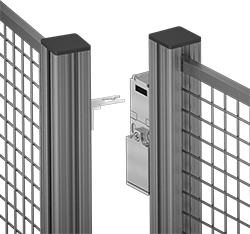
Also known as interlock switches, these ensure the safety of personnel by automatically shutting off power to machinery when an access door opens. Mount the switch to the door frame and mount a key to the door so that the key is inserted into the switch when the door is closed. When the door opens, the key is removed from the switch and the machine shuts down. They’re often used with machine guards for large robots.
All switches require an actuator key, but not all include one—check whether you need to pick out a separate actuator key. For some switch styles, you can also select the mounting orientation of the key.
Style A-G switches have positive-force, normally closed contacts that will open a circuit when the switch is actuated even if a spring fails or the contacts stick.
NEMA 4 rated switches protect against washdowns.

Housing | Conduit | |||||||||||||||
|---|---|---|---|---|---|---|---|---|---|---|---|---|---|---|---|---|
| Style | No. of Circuits Controlled | Switch Starting Position | Switch Action | No. of Terminals | Industry Designation | Switching Current @ Voltage | Max. Voltage | Ht. | Wd. | Dp. | Trade Size | Thread Type | Key Included | Environmental Rating | Each | |
Screw Terminal Connection with Positive-Force Normally Closed Contacts | ||||||||||||||||
| C | 2 | 1 Off (Normally Open) and 1 On (Normally Closed) | Stays Switched (Maintained) | 4 | DPST-1NO/1NC | 10 A @ 120 V AC, 2 A @ 24 V DC | 250V AC 24V DC | 3.6" | 2.1" | 1.3" | 1/2 | NPT | Yes | IP65, NEMA 4 | 00000000 | 0000000 |

























